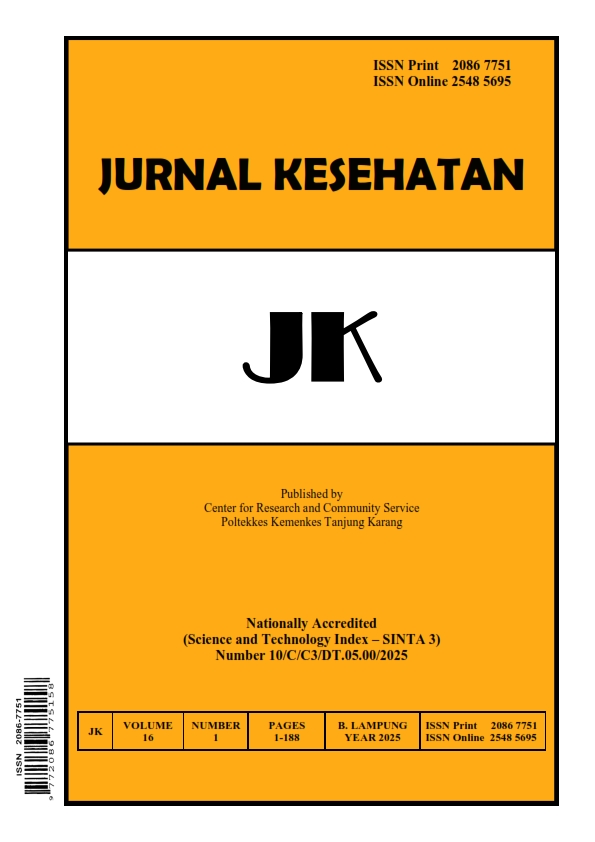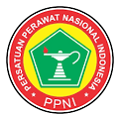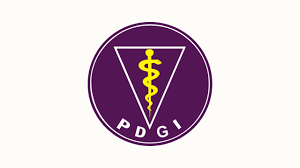Correlation of Lifestyle and Gender with Hypertension Incidence
DOI:
https://doi.org/10.26630/jk.v16i1.4713Keywords:
Blood Pressure, Hospital, Knowledge, PatientsAbstract
Hypertension is a disease whose initial cause is unknown, therefore hypertension is called a silent killer. Factors suspected of causing hypertension come from unhealthy lifestyles. In addition, gender is also a factor that affects blood pressure. The purpose of this study was to determine the relationship between lifestyle and gender and the incidence of hypertension. This study used a quantitative method, with a cross-sectional design. This population is based on research from a preliminary survey at Dr. Moewardi Surakarta Hospital of 10,252 patients. A sample of 109 participants was obtained using a purposive sampling technique. Research data were collected using a lifestyle questionnaire to measure the level of the patient's lifestyle. Data analysis used univariate tests and bivariate chi-square tests. From the study results, a p-value of 0.012 (<0.05) was obtained, which means a relationship exists between lifestyle and the incidence of hypertension. For the gender variable, a p-value of 0.013 (<0.05) was obtained, which implies a relationship exists between gender and the incidence of hypertension. The majority of 86 participants (78.9%) had a moderate lifestyle category. This study also showed that women tend to be at risk of hypertension, namely 48 participants (44.0%) of 64 female participants suffered from hypertension. Lifestyle and gender are significantly related to the incidence of hypertension. Men and women need to increase their knowledge about healthy lifestyles to improve hypertension prevention.
References
Atmadja, T. F. A., Yunianto, A. E., Yuliantini, E., Haya, M., Faridi, A., & Suryana, S. (2020). Gambaran sikap dan gaya hidup sehat masyarakat Indonesia selama pandemi Covid-19. AcTion: Aceh Nutrition Journal, 5(2), 195-202.
https://doi.org/10.30867/action.v5i2.355
Bruno, R. M., Pucci, G., Rosticci, M., Guarino, L., Guglielmo, C., Agabiti Rosei, C., ... & Pengo, M. F. (2016). Association between lifestyle and systemic arterial hypertension in young adults: a national, survey-based, cross-sectional study. High Blood Pressure & Cardiovascular Prevention, 23, 31-40. https://doi.org/10.1007/s40292-016-0135-6
Department Health of Central Java. (2021). Profil kesehatan provinsi Jawa Tengah tahun 2021, I-123. https://dinkes.jatengprov.go.id/buku-profil-kesehatan-v2/.
Fatmawati, BR, Suprayitna, M., & Istianah, I. (2021). Efikasi diri dan perilaku sehat dalam modifikasi gaya hidup penderita hipertensi. Jurnal Ilmiah Stikes Yarsi Mataram, 11(1),1-7. https://doi.org/10.57267/jisym.v11i1.73
Garwahusada, E., & Wirjatmadi, B. (2020). Hubungan jenis kelamin, perilaku merokok, aktivitas fisik dengan hipertensi pada pegawai kantor. Media Gizi Indonesia, 15(1), 60-65.
https://doi.org/10.20473/mgi.v15i1.60-65
Ghosh, S., Mukhopadhyay, S., & Barik, A. (2016). Sex differences in the risk profile of hypertension: a cross-sectional study. BMJ open, 6(7), e010085.
https://doi.org/10.1136/bmjopen-2015-010085
Gillis, E. E., & Sullivan, J. C. (2016). Sex differences in hypertension: Recent advances. Hypertension, 68(6), 1322-1327.
https://doi.org/10.1161/HYPERTENSIONAHA.116.06602
Ina, S. J., Selly, J. B., & Feoh, F. T. (2020). Analisis Hubungan Faktor Genetik Dengan Kejadian Hipertensi Pada Usia Dewasa Muda (19-49 Tahun) Di Puskesmas Bakunase Kota Kupang Tahun 2020. Chmk Health Journal, 4(3), 217-221. https://cyber-chmk.net/ojs/index.php/kesehatan/article/view/861
Livana, P. H., & Basthomi, Y. (2020). Triggering factors related to hypertension in the City of Kendal, Indonesia. Arterial hypertension, 24(4), 181-191. https://doi.org/10.5603/AH.a2020.0024
Pratiwi, O. M., & Wibisana, A. A. (2018). Hubungan Pola Makan Dengan Kejadian Penyakit Hipertensi Pada Lansia Di Dusun Blokseger Kecamatan Tegalsari Kabupaten Banyuwangi. Jurnal Ilmu Kesehatan Masyarakat, 14(2), 77-82.
https://doi.org/10.19184/ikesma.v14i2.10458
Sinuraya, R. K., Siagian, B. J., Taufik, A., Destiani, D. P., Puspitasari, I. M., Lestari, K., & Diantini, A. (2017). Pengukuran tingkat pengetahuan tentang hipertensi pada pasien hipertensi di kota bandung: sebuah studi pendahuluan. Jurnal Farmasi Klinik Indonesia, 6(4), 290-297.
https://doi.org/10.15416/ijcp.2017.6.4.290
Sufa, S. A. (2017). Tren gaya hidup sehat dan saluran komunikasi pelaku pola makan food combining. Jurnal Komunikasi Profesional, 1(7), 105-120.
https://doi.org/10.25139/jkp.v1i2.473
Susanti, N., Aghniya, S. N., Almira, S. S., & Anisa, N. (2024). Hubungan usia, jenis kelamin dengan penyakit hipertensi di klinik utama paru soeroso. Prepotif: Jurnal Kesehatan Masyarakat, 8(2), 3597-3604. https://doi.org/10.31004/prepotif.v8i2.30438
World Health Organization. (2023). Hypertension. https://www.who.int/news-room/fact-sheets/detail/hypertension.
Wulandari, I. S. M. (2020). Hubungan pola makan dengan kejadian hipertensi pada anggota prolanis Di wilayah kerja Puskesmas Parongpong. Chmk nursing scientific journal, 4(2), 228-236. https://doi.org/10.37771/kjn.v2i1.417
Yunus, M., Aditya, I. W. C., & Eksa, D. R. (2021). Hubungan usia dan jenis kelamin dengan kejadian hipertensi di puskesmas haji pemanggilan kecamatan anak tuha kab. Lampung Tengah. Jurnal Ilmu kedokteran dan kesehatan, 8(3), 229-239.,
Downloads
Published
Issue
Section
License
Copyright (c) 2025 Thia Wulan Dinasti, Sri Rahayu

This work is licensed under a Creative Commons Attribution-ShareAlike 4.0 International License.
Authors who publish in this journal agree to the following terms:
- Authors retain copyright and grant the journal right of first publication with the work simultaneously licensed under a Creative Commons Attribution License (CC BY-SA 4.0) that allows others to share the work with an acknowledgment of the work's authorship and initial publication in this journal.
- Authors can enter into separate, additional contractual arrangements for the non-exclusive distribution of the journal's published version of the work (e.g., post it to an institutional repository or publish it in a book), with an acknowledgment of its initial publication in this journal.
- Authors are permitted and encouraged to post their work online (e.g., in institutional repositories or on their website) prior to and during the submission process, as this can lead to productive exchanges and earlier and greater citations of published work.












